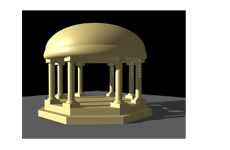
Lab 1: Introduction to Maya
IDS252: 3D Animation, Spring 2012

Due Date: Mon, Jan 23, before the beginning of class.
In class, we will walk through some of the more common things you will need to know about the interface and file server.
Mac vs PC Keyboard: The computers in Ford 202 are dual boot. If you hold down the "options" key as the computer boots up, it will give you the option of booting in Windows. If you do nothing, it will boot up as a Mac. At the moment, it does not matter which you use. However, for some of the things we do later, you will need to be working on the PC side which can cause confusion with the keyboard. To see the mappings of a PC keyboard on a Mac, go here.
Open up Maya 2012
Learning the Interface: An overview of the interface may be found here. Become familiar with the terms used to refer to the different parts of the interface, e.g. Menu sets, Status line, etc. Skim the first few pages of Chp 2 your text (DD).
Getting Help: It is important to become familiar with the online help. You will make constant use of it over the course of the semester. For example, in Maya, go to Help-Maya Help (F1). Under the Contents, select User Guide -> Basics -> Interface overview -> 3D coordinates to read about the Maya coordinate system. Read more about the Maya interface in the Maya Interface section. Poke around and explore what else is available.
Navigation: To do this part, it is best to have headphones. If a window titled Essential Skills Movies does not appear automatically, click on the menu Help;Learning movies. Take a look at movies 1 through 5 (i.e. "Zoom, pan, and roll" through "Discover secret menus"). As you watch, try things out in Maya itself. Also see the table in your text (DD) on page 34.
Location, location, location: Organizing and keeping track of files on your computer is critical! For the moment, you can just use your H-drive to store your Maya projects. Create a folder on your H drive called ids252. Create a Lab1 folder within ids252 to store all the files you will use or create for this lab. Within this folder, you will keep subfolders containing your Maya projects. Projects are described below. You should have at least one project for each lab.
To submit your completed images, you will place the images on the cs-render server before the beginning of class on the due date. This will be explained below.
Making a Project in your working folder: A Maya project is simply a folder or set of nested folders where all the files are stored. Projects are important to create because when you save or render maya scenes, a number of different files are generated and saved. If you have created and/or set a project, all of these files will be saved into the project folder, otherwise it is anyone's guess where many of these files will end up. For this lab, you will follow the directions given in the tutorial for creating a project.
 |
Downloading the Tutorial Files: In Maya, go to Help -> Tutorials. Go to the Maya 2012 section and download Getting Started 2012 Lesson Files (zip - 87695Kb) to your H:/ids252 folder. Unzip them (ask, if you don't know how). These are the files you will be using for all of the online tutorials. |
Helmet:
| The next thing you are to do is to learn how to create
a helmet using polygon
modeling.
As before, go to Help -> Tutorials, click on the link Getting Started with Maya 2012 and then go to Getting Started with Maya -> Polygon Modeling. |
To do the tutorial, you will make use of two files, HelmetFront.jpg and HelmetSide.jpg which are contained in the GettingStarted Lesson Files that you have already downloaded. The tutorial instructions will explain how to set everything up. IMPORTANT: Make sure you keep versions of your scenes as you progress so that, if necessary, you can go back to an earlier stage to correct a mistake. This is a long tutorial and can be rather tricky to do. If you don't get through the entire tutorial, then don't worry. Do as much as you can. The main goal is to get used to using the polygon modeling tools.
When you are done the tutorial, render a 640x480 jpeg image of your helmet, named appropriately, (e.g. orr_helmet.jpg)
Before the beginning of class on Monday, Jan 23, place your two jpg images (temple and helmet) into the ids252/Lab1 folder on cs-render. It is important that you name them as described above so that you get proper credit. Note, the Maya scene files will not be collected for this lab.
The main goal of this lab is to familiarize yourself with the Maya interface and basic modeling tools. Therefore, the lab will be graded on a pass-fail basis. To pass, you must complete the temple and have made an effort to have something resembling a helmet.
There is a lot to get used to in this first lab. If you have ANY questions, it is important that you ask.